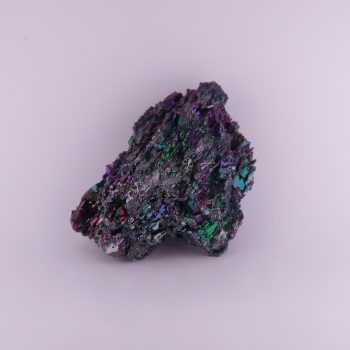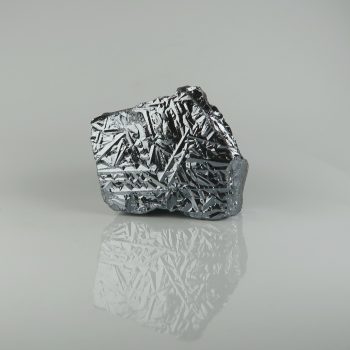Silicon
Silicon is a crystalline chemical element with the symbol Si. It is an extremely common element by mass, but rarely occurs in its pure form – typically as silicon dioxide (silica) or other silicate minerals.
Showing all 2 results
-

Silicon Carbide Specimens
Price range: £1.00 through £5.00 -

Silicon Specimens (Lab grown)
Price range: £2.00 through £4.00
Appearance, Uses and History
Silicon is a crystalline chemical element with the symbol Si. It is an extremely common element by mass, but rarely occurs in its pure form – typically as silicon dioxide (silica) or other silicate minerals.
In its pure form, it is a crystalline mass with a blue-grey metallic luster, very reflective.
Throughout history most silicon was used in its impure forms, the silicate minerals, in construction and ceramics – clays, silica sands, mortar, concrete, porcelain, and certain types of glass.
Silicon carbide is used as an abrasive, known as carborundum. The abrasive is commonly used in sandpapers, abrasive belts, resin abrasive wheels, etc.
When it occurs naturally, Silicon carbide is known as moissanite, an incredibly rare mineral. Synthetic moissanites are often used as a replacement for Diamonds.
Silicon is also used to make silicones, which are widely used as synthetic polymers.
Silicon has played a huge role in the modern age, as it is used in semiconductors, electronics, circuitboards and chips – essentially, the modern world runs on silicon. There’s a reason the American home of technology companies is called “Silicon Valley”!
Locales
It’s difficult to establish any locales for Silicon itself as it doesn’t occur often in its elemental form. Most pure (or near pure) Silicon is lab created by a reduction process.
Mineralogy
Silicon Carbide: Lab created abrasive with the formula SiC.
Elemental silicon: Elemental silicon is blue-grey, shiny and typically bears marks on at least one face from the process with which it was created.
Silicon carbide: an iridescent abrasive created during the production of Iron.
Silicon carbide: harder than streak plates
Silicon carbide: metallic
Silicon carbide: splintery
Silicon carbide: opaque
Silicon carbide: lab grown as boules or jagged, sharp aggregates.
Silicon carbide: 9
Silicon carbide: 3.1
Silicon carbide:
Silicon carbide: appearance, hardness, abrasive properties.
Photos of Silicon
Hazards and Warnings
Almost all rocks, minerals (and, frankly, almost all other substances on earth) can produce toxic dust when cutting, which can cause serious respiratory conditions including silicosis.
When cutting or polishing rocks, minerals, shells, etc, all work should be done wet to minimise the dust, and a suitable respirator or extraction system should be used.
Translations
Arabic:
- السيليكون (silicon)
- كربيد السيليكون (silicon carbide)
- كربورندم (carborundum)
Hindi:
- सिलिकॉन (silicon)
- सिलिकन कार्बाइड (silicon carbide)
- कारबरंडम (carborundum)
Portuguese:
- silício (silicon)
- carboneto de silício (silicon carbide)
Bengali:
- সিলিকন (silicon)
- সিলিকন কার্বাইড (silicon carbide)
Indonesian:
- silikon (silicon)
- silikon karbida (silicon carbide)
Punjabi:
- ਸਿਲੀਕਾਨ (silicon)
- ਸਿਲੀਕਾਨ ਕਾਰਬਾਈਡ (silicon carbide)
- ਕਾਰਬਰੁੰਡਮ (carborundum)
English:
- silicon
- silicon carbide
- carborundum
Italian:
- silicio (silicon)
- carburo di silicio (silicon carbide)
Russian:
- кремний (silicon)
- Карбид кремния (silicon carbide)
- карборунд (carborundum)
French:
- silicium (silicon)
- carbure de silicium (silicon carbide)
Japanese:
- ケイ素 (silicon)
- 炭化ケイ素 (silicon carbide)
- カーボランダム (carborundum)
Spanish:
- silicio (silicon)
- carburo de silicio (silicon carbide)
- carborundo (carborundum)
German:
- Silizium (silicon)
- Siliziumkarbid (silicon carbide)
- Karborund (carborundum)
Korean:
Thai:
- ซิลิคอน (silicon)
- ซิลิคอนคาร์ไบด์ (silicon carbide)
Gujurati:
Mandarin and Traditional Chinese:
- 硅 / 矽(silicon)
- 碳化硅 / 碳化矽 (silicon carbide)
- 金刚砂 / 金剛砂(carborundum)
Urdu:
- سلکان (silicon)
- سلکان کاربائڈ (silicon carbide)
- کاربورنڈم (carborundum)
